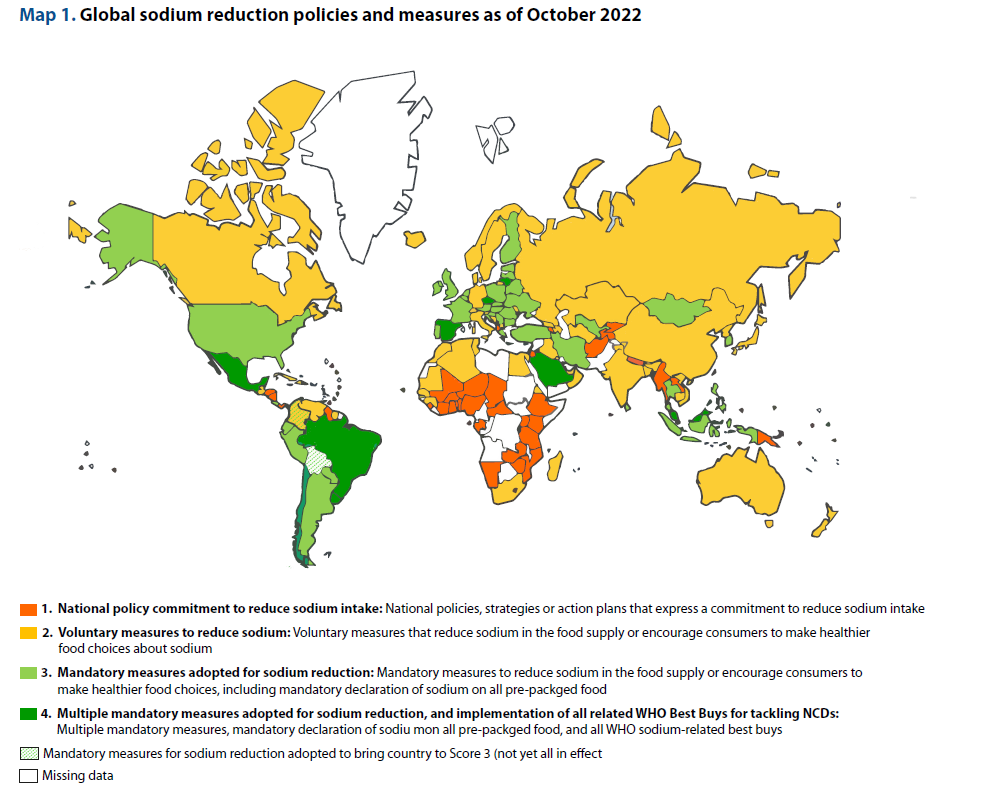World Health Organisation Global Report on Salt Reduction
A first of its kind global report published today from the World Health Organisation shows that the world is falling short of achieving its global target of reducing salt intake by 30% by 2025.
Read WHO Global Report on Sodium Intake Reduction [PDF 4,762KB]
Poor diet is now the leading cause of death and ill health globally. Of greatest concern is excessive salt consumption, whereby ~2 million deaths each year are linked to a high salt diet. Global salt intakes average 10.8g/day, more than double the WHO recommended limit for adults.
The World Health Organisation recognises the impact that salt reduction has on population health, and as such in 2013, 194 Member States committed to reducing population intakes by 30% by 2025. This comprehensive report from the WHO has reviewed the progress made by each Member State, assessing which countries have implemented recommended policies for improved health.
Key findings
- 5% Member States (9 countries) have implemented at least 2 mandatory salt reduction policies and other measures, and all WHO salt-related best buys for tackling noncommunicable diseases
- A further 22% (43 countries) have implemented at least one mandatory policy or measure
- 33% (64 countries) have implemented at least one voluntary policy and other measures to reduce salt intake
- 29% (56 countries) have made a policy commitment towards sodium reduction
- 73% of all Member States lack full range of implementation of such policies
Modelling indicates that current implementation of sodium reduction policies is thought to reduce global salt intake by 23% by 2030 , and reduce deaths from cardiovascular disease by 3%.
Reducing sodium intake is one of the most cost-effective ways to improve health and reduce the burden of noncommunicable diseases, as it can avert a large number of cardiovascular events and deaths at very low total programme costs. WHO recommends several sodium-related best buy policies as practical actions that should be undertaken immediately, to prevent cardiovascular disease and its associated costs. These include:
-
Reformulation
-
Implementing public food procurement and service policies to reduce salt content in food served or sold.
-
Implementing front-of-pack labelling to help consumers select food products with lower salt content
-
Conducting mass media campaigns to alter consumer behaviour around salt
A ‘Sodium Country Score Card’ was developed to assess country implementation of recommended policies and other measures, allocating a score from 1 (lowest level of implementation) to 4 (highest level of implementation).
The higher the income group, the higher the score reached. In terms of regional differences, the European Region has the highest level of scores 3 and 4. (See Map, WHO Global Report on Sodium Intake Reduction).
Dr Tedros Adhanom Ghebreyesus, WHO Director-General, said “Unhealthy diets are a leading cause of death and disease globally, and excessive sodium intake is one of the main culprits. This report shows that most countries are yet to adopt any mandatory sodium reduction policies, leaving their people at risk of heart attack, stroke, and other health problems. WHO calls on all countries to implement the ‘Best Buys’ for sodium reduction, and on manufacturers to implement the WHO benchmarks for sodium content in food.”
WHO calls on Member States to implement salt intake reduction policies without delay and to mitigate the harmful effects of excessive salt consumption.
How does the UK Compare?
The UK was once considered world leading in our approach to salt reduction, but this report shows other countries are taking greater measures to improve their nations’ health.
The UK has had a voluntary salt reduction programme in place for nearly 20 years, and at the start of the programme we saw some significant reductions in salt population salt intakes, with a profound impact on public health. Population salt intakes fell from 9.5g/day to 8.1g/day, and in the same period of time, population blood pressure and deaths from heart attacks and stroke also fell. Reducing population salt intakes by just 1g a day would save over 4,000 premature deaths from strokes and heart attacks, and save the NHS £288million every year.
Unfortunately progress has stopped, with no reported significant changes in salt intakes since 2009. UK salt intakes currently average 8.4g/day, 40% higher than UK limit of 6g/day. This makes it clear that the voluntary approach is no longer fit for purpose, and that now is the time for regulation with mandatory targets for food businesses, to make the healthier choice the easier choice for all.
Hattie Burt, Senior Policy and International Projects Officer, Action on Salt said “This report should serve as a wake-up call to the UK government as it highlights just how far the UK is from safe levels of salt intake. Reducing salt is one of the simplest and most cost-effective public health measures, so why is the government not jumping at this opportunity to save lives and reduce pressure on our struggling healthcare system? The majority of salt in the UK diet comes from processed foods, so it is food industry practice that needs to change. Regulation is the most effective way of doing this, as it creates a level playing field for companies. The government must commit to mandatory salt reduction targets to limit the excessive amount of salt the food industry adds to our food, or people more will continue to die.”



